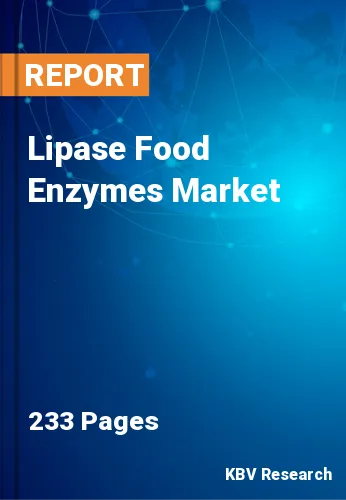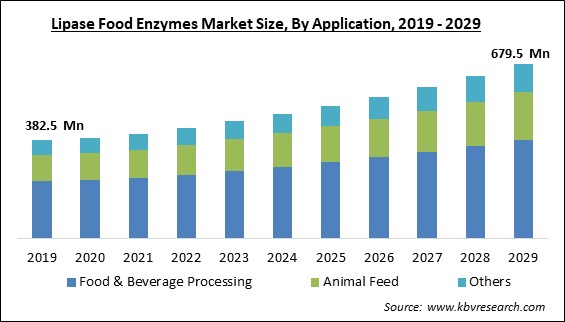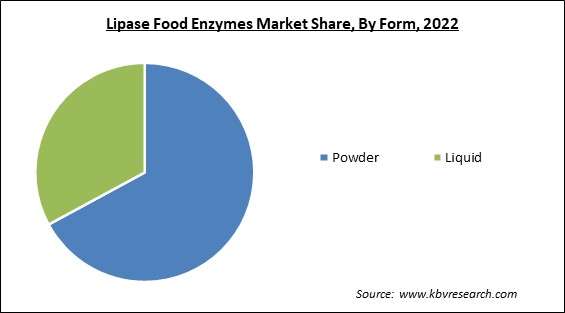
The Global Lipase Food Enzymes Market size is expected to reach $679.5 Million by 2029, rising at a market growth of 6.9% CAGR during the forecast period.
The breakdown of oils and fats into their more basic components, like fatty acids and glycerol, is accelerated by food enzymes called lipases. The human body and many different microorganisms, including bacteria, yeast, and fungi, naturally contain these enzymes. As a result, the food industry commonly uses lipase enzymes as an addition to create a variety of food products. For example, they can be applied to food goods to improve their flavor, texture, and nutritional value, as well as to extend their shelf life.

Food enzymes offer various functional qualities and can emulsify various food components. Food items benefit from food enzymes in a manner similar to how emulsifiers are used to boost the kinetic stability of food. Food enzymes have a significant advantage over emulsifiers in that they are classified as clean-label ingredients. The need for food enzymes is expanding globally as the rules governing the use of labeled additives become more stringent.
The ideal emulsifier substitute is thought to be the food enzyme lipase. When lipids are broken down into fatty acids and glycerol by lipase, the amount of fat in baked goods like bread and cakes is further decreased. Lipase also exhibits the qualities of emulsifiers. Food enzymes can be used in place of emulsifiers in dairy, confectionery, bakery, and other industries, which has the potential to boost the market growth.
From the perspective of digestion, lipase and amylase are absolutely necessary for the efficient operation of the digestive system. These aid in the digestion of lipids and aid in the breakdown of carbohydrates. Maintaining lipase within the normal range is vital because it is such a crucial component of the digestive system. In addition to aiding in digestion, the pancreatic enzyme lipase facilitates the transport of fats from the meal to other regions of the body. As a result, there is potential for an increase in demand for lipase during the forecasted time period.
Organizations in the food industry struggled to fulfill consumer demand, and income declined amid the pandemic. The temporary closure of some businesses exemplified how closely related various industries are to one another globally. Protecting employee health and maintaining worker accessibility owing to illness or workers refusing to report to work due to the fear of COVID infection was a major worry shared by all food organizations. Therefore, while the industrial uses of lipase increased, its demand decreased in the food industry because of its negative performance. However, as the awareness about healthy food increased, it affected the lipase demand positively. Thus, the pandemic had a moderate impact on the market.
Lipase enzymes are also utilized in medicine and for diagnostic purposes. Lipase enzymes can aid in the diagnosis of acute pancreatitis along with other gastrointestinal diseases in people through blood testing. In addition, lipase enzymes help patients receive pancreatic enzyme replacement therapy (PERT) by breaking down fats into lipids. The primary reasons propelling the lipase enzyme demand are the rising consumption of processed foods and meat and increased awareness of animal health. In light of these elements, it is anticipated that the value and volume of the lipase food enzymes market will increase in the coming years.
Directed evolution can enhance the characteristics of lipases that are important to the industry. Successful biotechnological applications of lipases include the manufacture of enantiopure medicines, flavor compounds, natural polymers, and biodiesel. In terms of the intended use appropriateness of the food enzymes generated, there are numerous small-scale producers competing with the market players in the world market. This, in turn, relies on the caliber of the producing strain created by producers. In addition, several technology licensees allow small-scale producers to create programmable enzymes that can be expanded to produce huge numbers. These kinds of elements are contributing to the expansion of the market.
Environmental factors in the immediate surroundings greatly impact how food enzymes operate. While thermal agitation breaks down the food enzyme, rendering it non-functional, a drop in temperature results in a sharp reduction in the reaction rate. Altering the pH outside the food enzyme's functional range also decreases the enzyme's activity and may eventually result in permanent denaturation. Although producers of food enzymes are working to create enzymes that can function in a wide range of temperatures and pH levels, there remains plenty of work to do before enzyme utilization is incorporated into every step of the manufacturing process for food and beverages. Therefore, these limitations associated with using lipase may restrict the market's growth.
Based on source, the lipase food enzymes market is characterized into microorganisms, animals, and plants. The microorganisms segment garnered the highest revenue share in the lipase food enzymes lipase food enzymes market in 2022. Among numerous additional industrial products, lipase food enzymes produced by microorganisms are employed in the production of detergents, processed foods, pharmaceuticals, and biofuels. Because they are very stable and specialized in terms of physiology, ecology, and metabolism, the microorganisms can function in tough environmental circumstances like high temperatures, harsh pH levels, and organic solvents.

On the basis of form, the lipase food enzymes market is classified into powder and liquid. The liquid segment recorded a significant revenue share in the lipase food enzymes market in 2022. Since milk fat is hydrolyzed using lipase, which is typically employed in liquid form in this process, liquid lipase is preferred over other forms of the enzyme. The majority of these are used in liquid form, whether they are flavor enhancers or coffee whiteners, aside from that. Adding liquid lipase to beverages or taking it orally directly is simple. If someone has trouble swallowing medications, using lipase as a dietary supplement may be an attractive option. The dropper frequently included with liquid lipase supplements makes accurate dosing possible.
By application, the lipase food enzymes market is divided into food & beverage processing, animal feed, and others. The food & beverage processing segment witnessed the maximum revenue share in the lipase food enzymes market in 2022. The food and beverage applications include processing meat, dairy, bakery, and nutraceuticals, as well as additional food products (like processed food, vegetable oil processing, and processed fruits & vegetables). In addition, peptides and amino acids are produced by processes such as the enzymatic hydrolysis of vegetable and yeast proteins and operate as flavor enhancers in canned, frozen, and ready-to-eat food products. These reasons have led to a growing demand for enzymes in the food industry.
| Report Attribute | Details |
|---|---|
| Market size value in 2022 | USD 429.5 Million |
| Market size forecast in 2029 | USD 679.5 Million |
| Base Year | 2022 |
| Historical Period | 2019 to 2021 |
| Forecast Period | 2023 to 2029 |
| Revenue Growth Rate | CAGR of 6.9% from 2023 to 2029 |
| Number of Pages | 233 |
| Number of Table | 430 |
| Report coverage | Market Trends, Revenue Estimation and Forecast, Segmentation Analysis, Regional and Country Breakdown, Companies Strategic Developments, Company Profiling |
| Segments covered | Application, Form, Source, Region |
| Country scope | US, Canada, Mexico, Germany, UK, France, Russia, Spain, Italy, China, Japan, India, South Korea, Singapore, Malaysia, Brazil, Argentina, UAE, Saudi Arabia, South Africa, Nigeria |
| Growth Drivers |
|
| Restraints |
|
Region wise, the lipase food enzymes market is analyzed across North America, Europe, Asia Pacific, and LAMEA. The North America segment recorded the largest revenue share in the lipase food enzymes market in 2022. The market in North America is being driven by several factors, including increased demand for processed and convenience foods, a growing awareness of the health benefits of eating foods enhanced by enzymes, and the development of novel applications and formulations for lipase enzymes. The main market expansion forces for lipase food enzymes are in the United States and Canada.
Free Valuable Insights: Global Lipase Food Enzymes Market size to reach USD 679.5 Million by 2029
The market research report covers the analysis of key stake holders of the market. Key companies profiled in the report include Chr. Hansen Holding A/S, Associated British Foods PLC (Wittington Investments Limited), Biocatalysts Limited (Brain Biotech AG), Novozymes A/S (Novo Holdings A/S), BASF SE, Infinita Biotech Private Limited, Antozyme Biotech Pvt Ltd, Jiangsu Yiming Biological Technology Co., Ltd., Creative Enzymes and Enzyme Development Corporation.
By Application
By Form
By Source
By Geography
The Market size is projected to reach USD 679.5 Million by 2029.
Numerous applications of lipase enzyme across various industries are driving the Market in coming years, however, Operating at a limited range of temperatures and pH restraints the growth of the Market.
Chr. Hansen Holding A/S, Associated British Foods PLC (Wittington Investments Limited), Biocatalysts Limited (Brain Biotech AG), Novozymes A/S (Novo Holdings A/S), BASF SE, Infinita Biotech Private Limited, Antozyme Biotech Pvt Ltd, Jiangsu Yiming Biological Technology Co., Ltd., Creative Enzymes and Enzyme Development Corporation.
The expected CAGR of this Market is 6.9% from 2023 to 2029.
The Powder segment is leading the Market by Form in 2022 thereby, achieving a market value of $435.9 million by 2029.
The North America market dominated the Market by Region in 2022, and would continue to be a dominant market till 2029; thereby, achieving a market value of $240.4 million by 2029.
Our team of dedicated experts can provide you with attractive expansion opportunities for your business.
